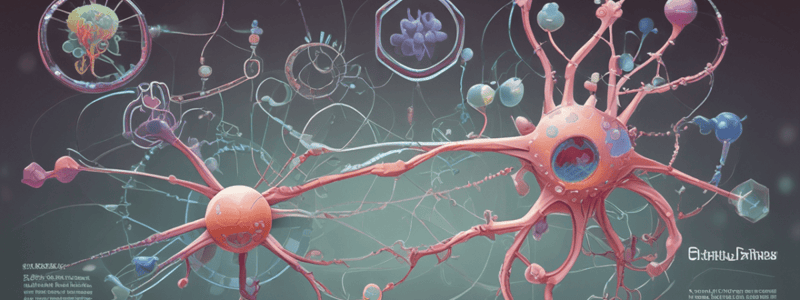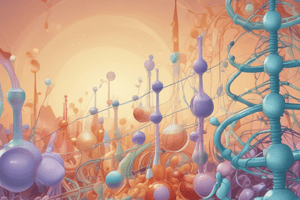Podcast
Questions and Answers
What is the primary bond responsible for holding two amino acids together?
What is the primary bond responsible for holding two amino acids together?
- Peptide bond (correct)
- Ionic attraction
- Hydrogen bond
- Covalent sulfur bond
What type of interactions are responsible for the tertiary structure of a protein?
What type of interactions are responsible for the tertiary structure of a protein?
- Hydrophobic and hydrophilic interactions (correct)
- Hydrogen bonds and peptide bonds
- Hydrophobic and ionic interactions
- Covalent sulfur bonds and ionic attraction
What is the term for the process of disrupting the native structure of a protein?
What is the term for the process of disrupting the native structure of a protein?
- Protein catalysis
- Protein synthesis
- Protein denaturation (correct)
- Protein folding
What is the role of enzymes in biological reactions?
What is the role of enzymes in biological reactions?
What is the term for short chains of amino acids containing fewer than 50 amino acids?
What is the term for short chains of amino acids containing fewer than 50 amino acids?
What is the level of protein structure that is dependent on the tertiary structure of individual polypeptides?
What is the level of protein structure that is dependent on the tertiary structure of individual polypeptides?
What is the role of the four calcium ions in thermolysin?
What is the role of the four calcium ions in thermolysin?
Which type of amino acid residues are resistant to heat cleavage by trypsin and chymotrypsin?
Which type of amino acid residues are resistant to heat cleavage by trypsin and chymotrypsin?
What is the function of CNBr in protein chemistry?
What is the function of CNBr in protein chemistry?
What is the purpose of hydrazinolysis in protein chemistry?
What is the purpose of hydrazinolysis in protein chemistry?
What is the primary structural component of all tissues in humans and other animals?
What is the primary structural component of all tissues in humans and other animals?
What are proteins composed of?
What are proteins composed of?
What is the term for the region of the enzyme molecule where the substrate binds?
What is the term for the region of the enzyme molecule where the substrate binds?
What is the term for the substance that an enzyme acts on in a reaction?
What is the term for the substance that an enzyme acts on in a reaction?
What is the term for an enzyme without its non-protein moiety?
What is the term for an enzyme without its non-protein moiety?
What type of cofactor is loosely bound to an enzyme by non-covalent bonds?
What type of cofactor is loosely bound to an enzyme by non-covalent bonds?
What is the term for the complex formed when a substrate binds to an enzyme?
What is the term for the complex formed when a substrate binds to an enzyme?
What type of cofactor is tightly bound to an enzyme by covalent bonds?
What type of cofactor is tightly bound to an enzyme by covalent bonds?
What is the primary function of gel electrophoresis in protein analysis?
What is the primary function of gel electrophoresis in protein analysis?
Which reagent reacts with the N-terminus of an amino acid?
Which reagent reacts with the N-terminus of an amino acid?
What is the specific function of trypsin in proteolytic cleavage?
What is the specific function of trypsin in proteolytic cleavage?
What is the purpose of using papaya (papain) in meat tenderization?
What is the purpose of using papaya (papain) in meat tenderization?
Which of the following is NOT a function of chymotrypsin?
Which of the following is NOT a function of chymotrypsin?
What is the reaction mechanism of Dansyl chloride with amino acids?
What is the reaction mechanism of Dansyl chloride with amino acids?
What is the biochemical activity of the enzyme catalase?
What is the biochemical activity of the enzyme catalase?
Which type of enzyme catalyses the reaction of joining two molecules with covalent bonds using energy from ATP?
Which type of enzyme catalyses the reaction of joining two molecules with covalent bonds using energy from ATP?
What is the biochemical activity of transaminases such as ALT and AST?
What is the biochemical activity of transaminases such as ALT and AST?
Which of the following enzymes is an example of a phosphotransferase?
Which of the following enzymes is an example of a phosphotransferase?
What is the biochemical activity of the enzyme phenylalanine hydroxylase?
What is the biochemical activity of the enzyme phenylalanine hydroxylase?
Which of the following enzymes is an example of a lyase?
Which of the following enzymes is an example of a lyase?
Flashcards
Amino Acids
Amino Acids
Building blocks of proteins, 20 types.
Peptides
Peptides
Short chains (fewer than 50 amino acids) linked by peptide bonds.
Polypeptides
Polypeptides
Longer chains of amino acids linked by peptide bonds.
Peptide Bond
Peptide Bond
Signup and view all the flashcards
Protein Denaturation
Protein Denaturation
Signup and view all the flashcards
Enzymes
Enzymes
Signup and view all the flashcards
Active Site
Active Site
Signup and view all the flashcards
Apoenzyme
Apoenzyme
Signup and view all the flashcards
Holoenzyme
Holoenzyme
Signup and view all the flashcards
Cofactor
Cofactor
Signup and view all the flashcards
Substrate
Substrate
Signup and view all the flashcards
Enzyme-Substrate Complex
Enzyme-Substrate Complex
Signup and view all the flashcards
Transferases
Transferases
Signup and view all the flashcards
Hydrolases
Hydrolases
Signup and view all the flashcards
Lyases
Lyases
Signup and view all the flashcards
Isomerases
Isomerases
Signup and view all the flashcards
Ligases
Ligases
Signup and view all the flashcards
Proteolytic Enzymes
Proteolytic Enzymes
Signup and view all the flashcards
Cyanogen Bromide (CNBr)
Cyanogen Bromide (CNBr)
Signup and view all the flashcards
Dansyl Chloride
Dansyl Chloride
Signup and view all the flashcards
Study Notes
Amino Acids and Proteins
- There are 20 different types of amino acids that constitute the monomer units of proteins.
- Amino acids are linked together by peptide bonds to form chains, which can be classified as peptides (short chains, fewer than 50 amino acids) or polypeptides (longer chains).
- Each protein has its own unique combination of amino acids.
Protein Structure
- Proteins have unique shapes due to bonding arrangements, including:
- Peptide bonds (primary)
- Hydrogen bonding (secondary and tertiary)
- Ionic attraction/bonds (tertiary)
- Hydrophobic and hydrophilic interactions (tertiary)
- Covalent sulfur bonds (tertiary)
- Quaternary structure is dependent on the tertiary structure of individual polypeptides and is influenced by these bonds.
Protein Denaturation
- Proteins can be denatured by:
- Heat
- Mechanical agitation
- Detergents
- Organic compounds
- pH changes
- Inorganic salts
Enzymes
- Enzymes are proteins that increase the rate of reaction by lowering the energy of activation.
- They catalyze nearly all chemical reactions in the body's cells.
- Enzymes are not altered or consumed during reaction.
- Example: Thermolysin, a thermostable zinc endopeptidase, contains zinc and four calcium ions necessary for its thermal stability.
Enzyme Structure and Function
- The active site is the area on the enzyme where the substrate or substrates attach.
- Enzymes contain a special pocket or cleft called the active site.
- Apoenzyme is an inactive enzyme without its non-protein moiety, while holoenzyme is an active enzyme with its non-protein component.
- Cofactors are non-protein chemical compounds bound to an enzyme, required for catalysis.
- Types of cofactors include coenzymes and prosthetic groups.
Enzymatic Reactions
- Substrate is the substance at the beginning of the enzymatic reaction.
- Enzyme-substrate complex forms when the substrate binds to the enzyme.
- Examples of enzymes include lactate dehydrogenase, glucose oxidase, and peroxidase.
Biochemical Activity
- Transferases: transfer functional groups between donor and acceptor molecules.
- Hydrolases: catalyze the hydrolysis of various bonds.
- Lyases: cleave various bonds by means other than hydrolysis and oxidation.
- Isomerases: catalyze isomerization changes within a single molecule.
- Ligases: join two molecules with covalent bonds using energy from ATP.
Chemical Methods
- Proteolytic enzymes: cleave polypeptides into smaller fragments.
- Cyanogen bromide (CNBr): cleaves at methionine residues.
- Dansyl chloride: reacts with primary amino groups to produce stable blue- or blue-green-fluorescent sulfonamide adducts.
- Other chemical methods: BNPS-skatole, formic acid, hydroxylamine, and 2-nitro-5-thiocyanobenzoic acid (NTCB).
Studying That Suits You
Use AI to generate personalized quizzes and flashcards to suit your learning preferences.



